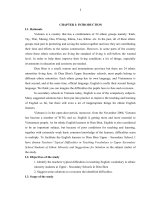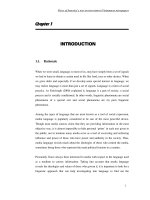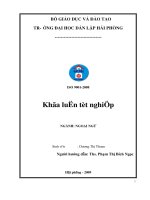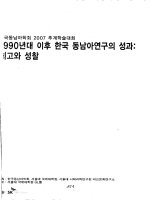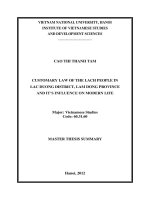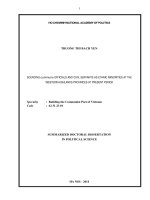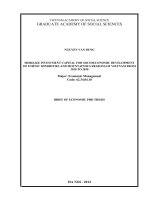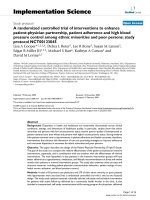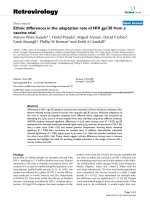Portrayal of ethnic minorities in printed newspapers
Bạn đang xem bản rút gọn của tài liệu. Xem và tải ngay bản đầy đủ của tài liệu tại đây (865.9 KB, 36 trang )
PORTRAYAL OF ETHNIC MINORITIES
ON PRINTED NEWSPAPERS
Institute for Studies of Society, Economy and Environment
PORTRAYAL OF ETHNIC MINORITIES
ON PRINTED NEWSPAPERS
A Collaborative Research Project between Institute for Studies of
Society, Economy and Environment
and Department of Sociology, Academy of Journalism
and Communication
Thế Giới Publishers
| 3
4 |
CONTENTS
1. INTRODUCTION
Overview of the social and media context
II. PORTRAYAL OF ETHNIC MINORITY PEOPLE
IN SPECIFIC AREAS
7
8
11
1. Economic issues
11
2. Socio-political issues
14
3. Cultural issues
16
4. Educational issues
18
5. General assessment on the depiction of ethnic minority people 19
III. ETHNIC MINORITY CULTURES
IN THE PRESS PERSPECTIVE
23
1. The trend of adding mythical flavours to the spiritual life
and traditional practices of the ethnic groups
23
2. The trend of adding romantic flavours to cultures
of the highlands
25
3. The trend of adding tragical flavours to the real life
of the ethnic groups
25
4. Factor which affect the writing style and comments on ethnic
minority groups
27
IV. RECOMMENDATIONS ON IMPROVEMENT
OF THE PRESS MESSAGE ON ETHNIC MINORITY GROUPS 31
V. EPILOGUE
35
| 5
6 |
I. INTRODUCTION
As a nation with different ethnic groups, Vietnam, throughout
history, has always promoted the solidarity policy so as to protect
and develop the country. The Communist Party of Vietnam affirmed
that “the issue of ethnic groups and unifying them is the long-term
and grassroots strategy for our course of revolution”1. However,
due to long-standing differences in culture, livelihood and habitat,
there are still misunderstandings, wrong judgments as well as social
biases between the majority Kinh group and other ethnic minority
groups which account for about 13% of the population. These affect
the equal development of the ethnic groups and general prosperity.
The press, and in a broader sense, the media play a vital role in the
elimination or, contrarily, reinforcement of those misunderstandings
and biases. The repetition of positive media messages can create
respect and fair behaviour toward ethnic minority groups; on
the contrary, negative ones can gradually cause disrespect and
lead to unfair treatment, or even feelings of inferiority in ethnic
minority groups, thereby taking away their opportunities for equal
development and contribution to the society.
Accordingly, Institute for Studies of Society, Economic and
Environment and Faculty of Sociology, Academy of Journalism and
Communication jointly conducted a research on media message
about ethnic minority groups on some printed newspapers in order
to (i) assess how some newspapers post articles and comments on
ethnic minority people, (ii) analyze the changes in the way of posting
articles and making comments over the years, and (iii) review the
possibility of such articles and comments from these newspapers
causing biases or anti-biases against ethnic minority groups.
The research was conducted on 500 articles which were collected
randomly from the 4 most popular newspapers at present, including
Thanh Nien, Tuoi Tre, Tien Phong and Cong An Nhan Dan, and
1. Resolution of the 10th Congress of the Communist Party of Vietnam, 2006.
| 7
were published in the years of 2004, 2006 and the first half of 2008.
The research unveiled, for the first time in Vietnam, characteristics
of the images of ethnic minority people and their cultures on
printed newspapers. This book is condensedly presenting the most
outstanding results of the research.
Based on the research outcomes, Dr Nguyen Van Chinh of Hanoi
National University wrote an article discussing how some printed
newspapers are communicating on ethnic minority groups. This
article has been published on some journals, and some of its excerpts
form part of this book.
Overview of the social and media context
In the past, ethnic minority groups in Vietnam were usually
referred to by general titles, such as the Thuong, the Tho. Being a
majority group, the Kinh, whether intentionally or not, usually
consider themselves superior to ethnic minority groups, and refer to
the Thuong and Tho as those of lower level of development who live
in remote areas with somewhat weird lifestyles2. The gaps between
these groups widened when the colonists promoted the theory of
cultural evolution to argue for their “civilization quest”, and applied
the policy of “division for domination” to sabotage people solidarity3.
As a result, prejudices among ethnic groups in Vietnam have more
or less existed through time as a product of history.
Identification of the composition of ethnic groups only
commenced in the early 1970s based on three criteria namely
language, culture and ethnic awareness. Accordingly, 54 ethnic
groups have been identified, which show recognition and respect for
the people living in the territory of Vietnam. The country is one of
the few ASEAN nations to assert the rights of ethnic minority people
in the Constitution, and has a nearly full-blown legal framework for
the recognition of equal status for ethnic minority groups.
However, according to the “Country Social Analysis: Ethnicity
2. Evidence of bias and, in some cases, discrimination from the Kinh, as the majority
group, against the Thuong and the Tho can be found in folk and romantic literature
in the first half of the 20th century, such as the works “Vàng và Máu” (Gold and
Blood) by The Lu, or “Chuyện đường rừng” (In the forest) by Lan Khai.
3. Cultural evolutionism: see Chapter III, 4.1, page 29
8 |
and Development in Vietnam” (World Bank 2009), prejudices against
ethnic minority groups was still rampant, and has been causing visible
effects on the equal development of the ethnic groups. Apart from
clear consequences in terms of poverty, education and healthcare, the
low self-esteem stands out when many groups estimate themselves
much lower than others do towards them.
A survey of the frequency and position of articles on ethnic
minority groups on newspapers partly reveals the modesty of this
topic. Only 4 out of 500 selected articles were posted on the first
page, which shows that the topic of ethnic minority groups is hardly
considered to be of special significance, or to attract particular
attention from the readers. The number of articles from 2006 to 2008
did not change significantly, which means the press did not show
any special changes of interests in this topic.
Statistics on the areas mentioned in these articles show an
imbalance in the media message on ethnic minority groups. In
terms of localities or the nature of incidents at specific localities, the
common trend was that disadvantaged areas were mentioned most
with 54% of the articles, followed by political “hot spots” (11.5%),
cultural tourism areas (11.1%), revolutionary base (6.7%), social evils
and drugs “hot spots” (3.6%), and other areas (21%). In general, more
than two thirds of the articles wrote about disadvantaged areas or
those with political and social evil issues, which creates an overall
negative impression on the localities of ethnic minority groups.
Another point, which is seemingly less important but also shows
an imbalance from the media against ethnic minority groups, is
that the media still fails to write the groups’ names correctly and
uniformly. Based on the List of Ethnic Minority Groups in Vietnam4,
65% of the articles whereby group names were specified did so
incorrectly, or even inadvertently. The act of correctly and uniformly
naming the groups will show national pride, self-awareness as well
as community respect for each of the group.
4. Published in 1979 by General Department of Statistics
| 9
10 |
II. PORTRAYAL OF ETHNIC MINORITY PEOPLE
IN SPECIFIC ISSUES
1. Economic Issues
Economic issues appear more as a secondary theme rather than
a primary theme of studied articles; however, leaving this aside,
economic issues would be the most popular, present in more than half
(51.8%) of the 500 articles in the research. Analysis of the economic
issues in these articles, which ranges from types of economic
operations, nature of production model, and status of the economic
entities to economic-related working and living conditions, shows
noticeable patterns in media messages.
Economic activities undertaken by ethnic minority people are
described quite vividly, yet most are related to agriculture. Other
activities such as service and trading, handicrafts, forestry, tourism
or freelance employment are also mentioned at a very low frequency,
which makes the image of ethnic minority people to be associated
with farming works.
Along with linking ethnic minority people to farming works,
the writers seemed to receive support for criticizing the production
models of the locals, and promoting the application of new ones.
Accordingly, the traditional production models are outdated and
connected to instability and risks:”...Kon Pne Commune…is the poorest
and most out-of-date one in the province…” because of “the obsolete
| 11
farming method, which uses buffalos to grind the soil before sowing” (case
462). In contrary, usage of the farming methods of lowlanders seems
to be the only key to economic development. “Having received basic
education, Vang Mi Co pondered: “my H’mong people are not lazy. But
why are we burdened with chronic poverty? It must be because of the ways
we work”. He read agricultural and forestry promotion books offered by
the government, and attended all trainings on agricultural promotion.
His family’s annual income, as a result, has now reached nearly VND 300
million per year…” (case 107).
No articles mentioned this topic under the broader context of
culture, society and environment to recognize the values of production
methods which were formulated in the ethnic groups’ process of
adapting to the nature for subsistence and growth. No questions on
the suitability of development programs to geographical areas and
cultures were raised, either. It is possible to say that the denial of
indigenous knowledge, weighing of high against low and advanced
against obsolete, and promotion of modern science and technology
as the only key to economic development are clear signs of cultural
evolutionism-related viewpoints5.
The image of ethnic minority people in economic areas also
appears on newspapers as being negative rather than positive. It
is noteworthy that the portrayal of ethnic minority people as being
self-motivated, creative and hard-working for not only self but
also community prosperity appears at quite a high rate (38.2% of
the articles); however, the image of ethnic minority people who are
disadvantaged, stuck, dependent or looking for economic support
still dominates (52.7% of the articles).
In terms of general assessment of ethnic minority people’s
economic conditions, apart from a modest rate of 20% of the articles
covering role models who are well off thanks to utilizing the right
economic methods, most describe the people in poverty and hunger
(64.2%) or escaping poverty (26.6%). “Poverty” and “hunger” are
still commonly-used words.
“…A Sapa is filled with the festive moods of the snowy days. The other
Sapa is shivering with fears of the natural catastrophe which could rip off
5. Cultural evolutionism: see Chapter III, 4.1, page 29.
12 |
the farmers’ meager capital, and push them from middle class to poverty, or
from poverty to extreme impoverishment” (case 110)
“…The hamlet is strategically located and convenient for self-sufficient
lifestyle; however the people of Doong hamlet are still facing constant
hunger.” (case 117)
“Traveling through the dry areas of the Central Highlands… drought
occurs right in the middle of the rainy season…” has forced the people into
“inevitable hunger, or more seriously, indebted to the bank…Millions of
Vietnam dong in debt and no way to repay…” (case 375)
Noticeably, ethnic minority people who are well off are usually
depicted individually, while those in poverty and in need of support
do not appear alone but, instead, as a community. All of these create
an overall negative impression on the economic conditions of ethnic
minority groups.
Explanation of the cause of poverty or escaping poverty
In addition to the trend of associating ethnic minority people
with poverty, the press also has an objective way of explaining how
they are burdened with poverty, or escape the state of poverty. In
analyzing the cause of poverty, a large portion of the newspapers
mentioned unfavourable natural conditions (32.7%) and other
factors which are directly related to the people such as lack of capital,
shortage of farming land, having too many children, bad health
condition (39.8%), or laziness, backward-thinking, incompetence
and involvement in social evils. Only a small number of the articles
(11.2%) mentioned the lack of support from the authorities.
On the contrary, in analyzing the cause of escaping poverty and
reaching the well-off level, many articles mentioned support from
the authorities (44%), associations as well as suitable policies of the
locality.
This shows that, on the one hand, the media tends to associate
ethnic minority people with poverty, while, on the other hand, trying
to explain the cause of poverty or escaping poverty in a subjective
way basing only on visible clues. It is therefore quite fair to say
that the stereotyped description and unequal judgments on the
newspapers have not only created a dull image of ethnic minority
| 13
people in economic areas but also an impression that they are the
only ones responsible for their difficult situations.
2. Socio-Political Issues
The socio-political area is a very broad one. Within the scope of
this research, this topic is structured into 6 prominent groups based
on the overall contents of the articles.
The most popular group is assistance activities for ethnic minority
people (47.5%), which, for most of the time, related to support for
meeting the basic and safety needs. These are considered the lowest
ones in the human demand ladder6. The areas most commonly referred
to in assistance activities are the Central Highlands, which appear at a
frequency three times higher than the next one, North Central region.
This difference easily leads to an incorrect deduction that ethnic
minority groups in the Central Highlands are the poorest and weakest
ones who need the most assistance. In fact, official statistics in the same
period show that the areas with the highest rate of poor ethnic minority
households are not the Central Highlands but North Central region
(20.4%), the North East (18.01%) and the Mekong river delta (17.55%)7.
Socio-political content
The group of security and government protection and sabotage
is the 2nd most popular topic (29.2% in total), which shows that
the localities of ethnic minority groups are usually regarded as
politically-sensitive or hot spots for political stability. The group of
social evils and crimes ranks 3rd, accounting for 12.8% of the articles.
6. According to the widely accepted Marslow’s hierachy of needs (1943)
7. According to Mai Thanh Son and associates (EMWG, 2007, page 70): Report on
analysis of secondary documents for the project entitled “Summary of development
approaches and searching for a mechanism to improve the voice of ethnic minority
groups”, funded by Oxfam Hong Kong.
14 |
Meanwhile, there are very few articles on the voice, participation
and decision-making rights of ethnic minority people, whereas this
should make up an important part of the socio-political area. Of the
500 analyzed articles, merely 3 wrote about the participation of ethnic
minority officers in local authorities, ethnic minority voters and
contribution to Party documents. On the one hand, this shows the
lack of participation by ethnic minority people in the policy-making
process. On the other hand, it shows that the voice and participation
of the people as an issue neglected by the press.
Image of ethnic minority people in the socio-political issues
It is not difficult to imagine that in nearly half of the articles about
assistance activities, ethnic minority people mainly appear as those
in disadvantaged situation, being passive and even dependent on
external assistance rather than finding ways to overcome difficulties.
Strong phrases and words showing clear social difference such as
“rescue work”, “aid”, “give”, “bring”, “grant”, “help”, “aspire”,
“taking care of” etc… are used commonly, thereby widening the
gap between the mountainous and plain areas, or the minority and
majority. This common depiction does not only create stereotypes
against ethnic minority people as being poor and dependent people,
but also reduce their self-esteem and increase their dependence on
external guidance and support.
Articles on the group of security and government protection
topics usually describe ethnic minority people as innocent, gullible
but acquisitive ones who are prone to coaxing and inducing to repel
the government, for example quoting a village patriarch: “On behalf
of the villagers, I apologize the government for not being able to eliminate
the people’s ignorance in the recent wrongful acts” and “public security
officers have provided wholehearted support to create favourable conditions
for the villagers. However, in their moments of unthoughtfulness, some
people forget this grace” (case 460).
As the voice and right to make decision of ethnic minority people
are rarely mentioned on newspapers, their participation, if written
about, is understandably not in an active way. Instead, they are
usually the subject for “communication and explanation of guidelines and
policies of the Party and State, and to encourage compliance…” (case 684).
| 15
Analysis of the socio-political topics shows the patterns in media
message on ethnic minority groups, i.e. they are associated with the
needs for social assistance; must receive guidance so as to avoid being
induced to sabotage the government; and need proper instruction
to observe guidelines and policies rather than actively participate in
the decision making process. In short, they are described as being
dependent, backward-thinking and in need of external assistance for
livelihood and growth.
3. Cultural Issues
The topic of ethnic minority culture is also divided into specific
groups based on the appearance of issues in the articles as well as
the viewpoints and attitude of the writers. Out of 149 articles which
mentioned cultural issues, the preservation and promotion of
traditional cultural characteristics is discussed the most, accounting
for 55.7%, followed by elimination of depraved customs (27.5%),
fading culture (10.7%), and efforts to maintain traditional cultural
activities (2.7%).
More than half of these articles wrote about the issues of
preservation and promotion of traditional cultural characteristics,
which shows the press interests in this area. The articles described
ethnic minority people as the most active participants in the
preservation of traditional culture (77.8% of the articles). Nevertheless,
the main characters are usually the elderly (village patriarch) or those
with prestige and high social position. In many cases, it seems like
the elderly are the only ones in the community who retain memories
of the culture and long for preservation:
“The Bahnar people…still maintain unique cultural heritages…
and the only one capable of telling these epics is the old A Bek…”
(case 680)
“…The village patriarch will advise young villagers … so that all
will maintain and promote together … ” (case 69)
The youth and ordinary people rarely appear as active subjects in
this process. Even though most writers asserted that the traditional
culture of ethnic minority groups must be respected and preserved,
the absence of ordinary community members in the process of
16 |
cultural innovation, practice and preservation is a worrying fact. The
press has however only paid attention to preservation of traditional
characteristics and totally neglected this fact.
More than a quarter of these articles concentrated on criticizing
outdated practices, showing that the people “are not only burdened
with livelihood responsibilities but also lots of depraved customs”
(case number 449). These practices are quite diversified, with main
focus on marriage, birth, healthcare, social evils, and details which
highlight the backward-thinking as “being barbarous”.
“…the locals refuse to take medicine for any kind of diseases and
sickness, as they believe that sickness is caused by ghosts, and only ask
ritual priests to perform curing rituals” (case 171)
“Pregnant women due for delivery must go into the jungles and take
care of everything by themselves …” (case 306)
“If the mother passes away, the child must either be buried, killed or left
in the jungles for predators because it is believed that the child is a ghost”
and “if twins are born, one must be buried” (case 318)
“Mr. Kring K’Hong Nha, chairman of Dac Mon commune, admitted
with me that, when returning to the village at night, he had heard infants
crying besides new graves many times but dared not to save them” (case
457)
The reason ethnic minority people still exercise these practices
is due to lack of legal understanding, or adhesion to the old ways
regardless of the law: “… the Law on Marriage and Family stipulates
that girls can only marry at the age of 18, and boys at 20; however, we
need to stick to the customs of our H’mong people” (case 626). Anybody
who dares to request removal of these practices will “be hated by the
villagers, and must move to live on the edge of the village” (case 457). In
the presence of these descriptions, ethnic minority people in the eyes
of the readers are not only backward-thinking but also extremely
conservative so as to maintain their obsolescence.
The content of media messages shows a serious conflict in
the cultural life of ethnic minority groups under the pressure
of development, i.e., with the same cultural characteristics and
traditional lifestyle, the people have to preserve what is regarded
| 17
(by outsiders) as good, while eliminating what is considered (also
by outsiders) as out-dated. Throughout this conflict-stricken process,
ethnic minority people appear as being passive and led by external
guidance rather than internal needs and aspirations.
4. Educational Issues
Education and training is an area which receives special attention
from the State in the development of ethnic minority regions. This is
also represented on newspapers, with a high volume of articles on
educational areas (149 articles, or 30% of the total number). Students
in ethnic minority region are mainly described in two contradictory
perspectives: school dropouts or exemplary models.
The most widely-covered content is the school-quitting
phenomenon (more than 32% of the articles) with a range of reasons
relating to the students themselves or their families including inability
to absorb the knowledge, lack of support from the family, working/child
minding, difficult economic
A study conducted in Vietnam in
conditions,
premature
2010 by independent consultants for
marriage. In general, the
the United Nation’s Human Right
reason for quitting school can
Council shows that the most common
be attributed to poverty and
reasons for ethnic minority children
lack of awareness because
to drop out of schools include: high
“there would be nobody to help
tuition fee, high opportunity costs
with farming work, and crops
(ethnic minority children usually
can be consumed, not letters”
have to work to help their families),
(case number 491). Other
difficult instructions/lessons and
reasons relating to teachers
significant distance from home to
or language differences were
school. The study shows that ethnic
only mentioned 3 times
minority children could not study
in the researched articles,
in their mother tongue in the first
whereas an independent
years of schooling, and thus face a
lot of difficulties in absorbing the
study shows that these are
knowledge and advancing to higher
the most common causes
grades.
of ethnic minority children
quitting school.
Nearly 27% of the
articles praised examples
18 |
( />bodies/hrcouncil/docs/16session/AHRC-16-45-Add2.pdf)
of dedicated students, yet these were mostly related to subjective
reasons such as the students’ diligence and support from their
families. The roles of teachers, local authorities and associations
were minimal in these positive articles.
Similar to the biased explanation of poverty, the media tried to
find out the reasons why ethnic minority students recorded poor
schooling results in the students themselves and their families, rather
than looking from different perspectives and in a broader context.
5. General Assessment on the Portrayal of Ethnic Minority People
in Printed Newspapers
Analysis of each topic and group of contents shows more negative
than positive image, which is based on partial rather than objective
and multi-faceted viewpoints. Analysis of methodology issues such
as media language and bias/non-bias attitude also show similar
representations.
Language
For statistics and analysis purpose, the language used in the
articles is grouped figuratively into the positive implication group
such as healthy – beautiful; nice, honest, warm-hearted, united, gentle,
active, creative, self-motivated, intelligent, overcoming difficulties,
modern, forward-thinking, advanced, preserve, promote, characteristics,
loyal etc… and the negative implication one such as poverty/hunger,
disadvantaged, shabby, deprived, backward-thinking, depraved customs,
child/premature marriage, lots of children, superstition, lazy, perturbative,
reactionary, induce etc…
Using the above groupings of words, the writers use significantly
more negative than positive-implication words when it comes to
describing ethnic minority groups. As much as 41% of the articles
use only the negative implication group of words, compared to 24%
with the positive implication group, and 35% with both groups.
Among the articles where the negative implication group is used,
the sub-group of words describing economic conditions, for example
poverty, disadvantaged, deprived, shabby, difficult, borrow, indebted, is most
popular, accounting for 65.8% of the total number. The sub-group of
words describing lifestyle such as backward-thinking, depraved customs,
| 19
superstitious, lack of understanding is the 2nd most popular one (23.6%). The
sub-group of words describing character and behaviour such as lazy,
pertubative, reactionary, induce, illegal ranks 3rd (18.7%). The remainder
consists of other words such as child/premature marriage, lots of children,
sick and ill, timid, shy, dependent etc… The wide use of such negative words
and expressions on newspapers can easily cause bias and consolidate
the negative understanding of ethnic minority people as those who are
backward-thinking, poor, dependent and non-decisive.
Analysis of the correlation between usage of words and publishing
time also shows that the ratio of positive words, which is already
low, tends to decrease over time, and vice versa, the ratio of negative
words which is already high tends to increase over time. The ratio
of positive words and expressions increases sharply from 16% in the
1st and 2nd quarters of 2004 to 29.8% in the 3rd and 4th quarters of the
same year, but decreases gradually to a mere 9.8% in the 1st and 2nd
quarters of 2008. On the contrary, the sub-group of negative words
and expressions declines from 36.1% in the 1st and 2nd quarters of 2004
to 19% in the 3rd and 4th quarters of the same year, but rises slowly
to 36.9% in the 1st and 2nd quarters of 2008. This shows, despite the
development of the society and the State’s efforts in narrowing the
gaps between ethnic groups, the media’s viewpoint and assessment
of ethnic minority people seems not to have improved.
As a result, while readers could picture ethnic minority people
as those who are active, creative, self-motivated, intelligent, hardworking, diligent, or healthy, beautiful, nice, warm-hearted, honest,
united, gentle, they can not neglect the more prominent images of
the people being poor, disadvantaged, deprived, shabby, difficult,
20 |
indebted, lack of knowledge (low or no education), backwardthinking, superstitious. By repeating negative words and expressions
at a high frequency, articles on printed newspapers can attach a
negative image and deepen the bias against ethnic minority people.
Level of prejudices against ethnic minority people
The writers’ prejudiced attitude is not only represented by words
which are either negative or positive, but, in a more discreet way, is
also implied. Judgments basing on the viewpoints of the lowlanders
or in comparison with the Kinh are very common.
“Unlike with the Kinh…we have to come to them to provide healthcare
services…” (Case 306)
“In the newly-built house, furniture and utensils are comparable to
those of the lowlanders. There are also flat-screen television, motorbike,
good refrigerator, expensive chairs and tables …” (Case 674)
“In the first days when the Ma Lieng moved to Ca Xen hamlet, Mr. Cao
Chau, the then head of hamlet, insisted on a low house which is close to the
main street like the Kinh’s. When asked about the reason, Mr. Chau said:
“I would like to see if living in a low house is better than in a stilt house, so
that I could ask and encourage the villagers to follow” (Case 302)
Even when the characters are described positively, the bias attitude
and lack of equality still reveal through the use of immoderate
language, slang or foreign languages
“…Looking at the young and inexperienced face of the opposite person,
one can hardly believe that he is the owner of the largest herd of cows and
goats on the rock plateau, and the youngest best farmer in 2007 nationwide.
Vang Mi Co told his life story in the Kinh language so clearly that commune
officer and interpreter became “redundant”” (Case 107)
“…the house in front of us is not the usual stilt house made from wood
and neohouzeaua by the highlanders but a solidly-built work with glass
doors and windows, and flat roof like a real lowlander’s residence. Sitting
in the armchair in his spacious house which is beautifully tiled,, the old
man used the remote control to turn on the 21” screen television on the
magnificent stand to watch the news…”(Case 377)
The analysis of 500 articles shows most writers have prejudices
| 21
at different levels in their writing about ethnic minority people. In
general, 17% of the articles are biased, 52% are strongly biased, while
only 31% are identified as unbiased. In terms of chronology, the level
of bias in the articles does not change much, and remains at a high
level, which shows that the bias against ethnic minority people on
printed newspapers is widespread and long-standing.
22 |
III. ETHNIC MINORITY CULTURES IN THE PRESS
PERSPECTIVE
Quantitative analysis results presented above show the depiction
of negative rather than positive aspects, with a high rate of prejudices,
is a prominent characteristic of Vietnamese newspaper articles on
ethnic minorities. The qualitative analysis continues to point out
these articles usually portray ethnic minority cultures under some
popular patterns, despite the diversified content and method of
communication. These patterns can be grouped into three main
trends, namely (1) “adding mythical flavours”; (2) “adding romantic
flavours”; and (3) “adding tragical flavours”.
1. The trend of adding mythical flavours to the spiritual life and
traditional practices of the ethnic groups
In the past, the remote and mountainous areas with ethnic
groups alien to the lowlanders’ imagination always seem to be full
of mythical things. Today, although stories with fictious elements are
no longer popular as the gaps between the low and high lands are
increasingly being narrowed, the differences in the cultural life of the
ethnic groups are still of great interests to readers. This is probably
why the newspapers are particularly interested in strange customs,
and either describes them as mythical or labels them as outdated,
wild and ignorant. This type of articles mainly focuses on four main
groups of topics as follows:
• Unique customs in relation to marriage, family and love of ethnic
minority groups such as “cướp vợ” (wife abduction)8 by some
groups in the Northern mountains, or sororate and levirate
marriage9 by some groups in the Central Highlands. Similarly,
8. “Wife abduction” is popular in H’mong and Dao language speakers in the Northern
mountainous areas. This practice usually takes place when the young ones are in
love but are unable to organize a traditional wedding, and the woman intentionally
agrees to be ‘stolen’ by the man. The practice is duly recognized by the community’s
common laws, but must adhere to strict conditions. There have been criticisms that
this practice is an excuse for child, arranged and traded marriages.
9. Many ethnic minority groups in the Truong Son mountain range – Central Highland
| 23
there are variations of the “love market”, the youth’s practices
for finding the love such as ngu mai (lay down and talk with
each other), ngu tham (home visit at night time), ngu chung
(sleep together), di sim (sleep at the village’s common house),
choc san (hit the floor with a pole); the custom of showing the
breast and nude bath by mountain girls etc…
• Differences in culinary customs such as the practice of hunting
and boning wild animals, fishing on the upstream of rivers
and springs, preparation of strange dishes and eating habits
of the groups. While recognizing these practices as the unique
characteristics of ethnic culture, the articles tend to emphasize
the “secret hands-on” techniques or assign special spiritual
meanings to them.
• Local beliefs, traditional festivals and sacred spaces of the groups,
such as rituals for the gods, offerings, sacrifices (e.g. buffalostabbing festival, peace festival, Gau Tao festival etc…),
fertility rites and cults, and sinh thuc khi rituals, sacred spaces
(e.g. holy forest, haunted jungle, ancient, abandoned and
mythical temples, shrines and architectural structures.
• Funeral-related practices of ethnic minority groups are also
targeted and regularly mentioned on newspapers so as to
attract readers’ curiosity. Regardless of their aim on attentiondrawing elements of the practices, the press usually includes
calls for abolition of such in their articles.
The effects of this writing trend usually result in a distorted
perception of ethnic minority culture by readers, as well as adverse
reactions from the concerned ethnic minority groups.
There are actually no love markets. Markets like Sapa and Khau Vai
are actually the place for exchange of culture, information and feelings.
areas still maintain the practice. Accordingly, a widower can marry the younger
sister of the deceased (anthropologists call this the sororat phenomenon). Similarly,
the widow can marry the younger brother of the deceased (aka levirat). This practice
is also popular in different tribes in the world. Human right activists claim that
this is a depraved custom because it violates the humans’ freedom to marry, and
instead tying them to strict practices. However, there are also claims that this is a
highly-humanitarian practice because it ensures that children who lost a parent are
properly cared for and brought up, while the family life is well maintained.
24 |
Nevertheless, some Kinh people inflate that Khau Vai is the place where
former couples meet up and do whatever they want. Those stories are totally
made up. (Cu Hoa Van, 2009)10
2. The trend of adding romantic flavours to the cultures of the
highlands
In addition to the trend of casting a mythical shadow over ethnic
minority culture to draw on readers’ curiosity, the other trend of
‘adding romantic flavours’ to ethnic culture also carries significant
weight on the newspapers. In journalists’ words, the landscape
of mountainous regions shows up as magnificent as in scenery
paintings, and there are rarely-seen products, unique specialties,
ideal relaxing space, as well as special cultural characteristics of
innocent people waiting to be discovered etc… In reading these,
we can’t help picturing a totally different mountainous area which
is not outdated, backward-thinking, poor, painless, but only shows
‘innocent smiles’ and ‘eyes which are brighter than the flames’. These
‘romantic flavour’ articles typically fall into the following patterns:
a) Praising the scenery with rivers and springs, mountains,
valleys, terraced fields, villages and stilt houses.
b) Describing the beauty or specialty of local products such as
brocade, forest and native goods, flora and fauna.
c) Introducing and promoting the mountainous culinary joys
such as types of wines, traditional remedies, local dishes as
well as leisurely habits such as traditional dances, singing,
and drinking
d) Exaggerating the romantic side of mountainous women’s
beauty.
3. The trend of “adding tragical flavours” to the real life of ethnic
groups
While more than 50% of the articles wrote about the actual economic
state of ethnic minority groups in the mountainous areas, the topic of
poverty and disadvantaged areas takes up a significant part (54%) of
10.“Do not misinterpret national culture”
/>
| 25
